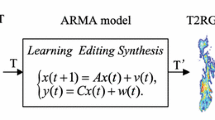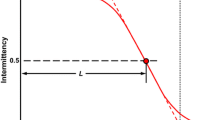Abstract
We propose a novel method conceptualized from the properties of physics where in particular the shape of a flame is determined by temperature that enables a control mechanism for the intuitive shaping of a flame. We focused on a trade-off issue from computer graphics whereby the turbulent flow that expresses the characteristics of the flame has a tendency to shift continuously, whereas the velocity constraints that contain a fluid within a target shape have a tendency to force movement in a particular direction. Trade-off made it difficult for animation designers to maintain a flame within the intended target shape. This paper resolves the issue by enabling the flame to be controlled without any velocity constraints by using the following two techniques: First, we model the temperature and force of the explosion generated by the combustion of explosive gaseous fuel and apply it to certain regions. Second, we expand the space of the interface between the fuel and the burned products, classifying that space into four regions and controlling the target shape of the flame by delicate adjustments to the temperature in each region. Experiments show that the flame maintains the appearance of dynamic movement while preserving the detailed 3D shapes specified by the scene designers.









Similar content being viewed by others
References
Bridson, R.: Fluid Simulation for Computer Graphics. A K Peters/CRC Press (2008). http://www.worldcat.org/isbn/1568813260
Fattal, R., Lischinski, D.: Target-driven smoke animation. ACM Trans. Graph. 23(3), 441–448 (2004). doi:10.1145/1015706.1015743
Feldman, B.E., O’Brien, J.F., Arikan, O.: Animating suspended particle explosions. ACM Trans. Graph. 22(3), 708–715 (2003). doi:10.1145/882262.882336
Foster, N., Metaxas, D.: Controlling fluid animation. In: Proceedings of the 1997 Conference on Computer Graphics International, IEEE Computer Society, CGI ’97, p. 178. Washington, DC, USA (1997). http://dl.acm.org/citation.cfm?id=792756.792862
Hong, J.M., Kim, C.H.: Controlling fluid animation with geometric potential. Comput. Animat. Virtual Worlds 15(3–4), 147–157 (2004). doi:10.1002/cav.v15:3/4
Hong, J.M., Kim, C.H.: Discontinuous fluids. ACM Trans. Graph. 24(3), 915–920 (2005). doi:10.1145/1073204.1073283
Hong, J.M., Shinar, T., Fedkiw, R.: Wrinkled flames and cellular patterns. ACM Trans. Graph. 26(3) 47:1–47:6 (2007). doi:10.1145/1276377.1276436
Hong, Y., Zhu, D., Qiu, X., Wang, Z.: Geometry-based control of fire simulation. Vis. Comput. 26(9), 1217–1228 (2010). doi:10.1007/s00371-009-0403-8
Horvath, C., Geiger, W.: Directable, high-resolution simulation of fire on the gpu. ACM Trans. Graph. 28(3), 41:1–41:8 (2009). doi:10.1145/1531326.1531347
Jeong, S., Kim, C.H.: Combustion waves on the point set surface. Comput. Graph. Forum 32(7), 225–234 (2013)
Kang, M., Fedkiw, R.P., Liu, X.D.: A boundary condition capturing method for multiphase incompressible flow. J. Sci. Comput. 15(3), 323–360 (2000). doi:10.1023/A:1011178417620
Kawada, G., Kanai, T.: Procedural fluid modeling of explosion phenomena based on physical properties. In: Proceedings of the 2011 ACM SIGGRAPH/Eurographics Symposium on Computer Animation, SCA ’11, pp. 167–176. ACM, New York, NY, USA (2011). doi:10.1145/2019406.2019429
Kim, Y., Machiraju, R., Thompson, D.: Path-based control of smoke simulations. In: Proceedings of the 2006 ACM SIGGRAPH/Eurographics Symposium on Computer Animation, SCA ’06, pp. 33–42. Eurographics Association, Aire-la-Ville, Switzerland, Switzerland (2006). http://dl.acm.org/citation.cfm?id=1218064.1218069
Nguyen, D.Q., Fedkiw, R., Jensen, H.W.: Physically based modeling and animation of fire. ACM Trans. Graph. 21(3), 721–728 (2002). doi:10.1145/566654.566643
Raveendran, K., Thuerey, N., Wojtan, C., Turk, G.: Controlling liquids using meshes. In: Proceedings of the ACM SIGGRAPH/Eurographics Symposium on Computer Animation, SCA ’12, pp. 255–264. Eurographics Association, Aire-la-Ville, Switzerland, Switzerland (2012). http://dl.acm.org/citation.cfm?id=2422356.2422393
Ross, G.: The Hunger Games. Lions Gate Films (2012)
Selle, A., Rasmussen, N., Fedkiw, R.: A vortex particle method for smoke, water and explosions. ACM Trans. Graph. 24(3), 910–914 (2005). doi:10.1145/1073204.1073282
Sethian, J.: Level Set Methods and Fast Marching Methods: Evolving Interfaces in Computational Geometry, Fluid Mechanics, Computer Vision, and Materials Science. Cambridge Monographs on Applied and Computational Mathematics. Cambridge University Press (1999). http://books.google.co.kr/books?id=ErpOoynE4dIC
Shi, L., Yu, Y.: Controllable smoke animation with guiding objects. ACM Trans. Graph. 24(1), 140–164 (2005). doi:10.1145/1037957.1037965
Shi, L., Yu, Y.: Taming liquids for rapidly changing targets. In: Proceedings of the 2005 ACM SIGGRAPH/Eurographics Symposium on Computer Animation, SCA ’05, pp. 229–236. ACM, New York, NY, USA (2005). doi:10.1145/1073368.1073401
Shin, S.H., Kim, C.H.: Target-driven liquid animation with interfacial discontinuities. Comput. Animat. Virtual Worlds 18(4–5), 447–453 (2007)
Stam, J.: Stable fluids. In: Proceedings of the 26th Annual Conference on Computer Graphics and Interactive Techniques, SIGGRAPH ’99, pp. 121–128. ACM Press/Addison-Wesley Publishing Co., New York, NY, USA (1999). doi:10.1145/311535.311548
Thürey, N., Keiser, R., Pauly, M., Rüde, U.: Detail-preserving fluid control. In: Proceedings of the 2006 ACM SIGGRAPH/Eurographics Symposium on Computer Animation, SCA ’06, pp. 7–12. Eurographics Association, Aire-la-Ville, Switzerland, Switzerland (2006). http://dl.acm.org/citation.cfm?id=1218064.1218066
Yang, B., Liu, Y., You, L., Jin, X.: A unified smoke control method based on signed distance field. Comput. Graph. 37(7), 775–786 (2013). doi:10.1016/j.cag.2013.05.001. http://www.sciencedirect.com/science/article/pii/S0097849313000757
Yngve, G.D., O’Brien, J.F., Hodgins, J.K.: Animating explosions. In: Proceedings of ACM SIGGRAPH 2000, pp. 29–36 (2000). http://graphics.cs.berkeley.edu/papers/Yngve-AEX-2000-07/
Acknowledgments
This research was supported by Basic Science Research Program through the National Research Foundation of Korea (NRF) funded by the Ministry of Education, Science and Technology (NRF-2013R1A1A2011602, NRF-2014R1A2A2A01007143, NRF-2015R1A1A1A05001196, NRF-2015R1C1A2A01053543) and the Technological Innovation R&D Program (S2172401) funded by the Small and Medium Business Administration.
Author information
Authors and Affiliations
Corresponding author
Electronic supplementary material
Below is the link to the electronic supplementary material.
Supplementary material 1 (mp4 23348 KB)
Rights and permissions
About this article
Cite this article
Kim, T., Lee, J. & Kim, CH. Physics-inspired controllable flame animation. Vis Comput 32, 871–880 (2016). https://doi.org/10.1007/s00371-016-1267-3
Published:
Issue Date:
DOI: https://doi.org/10.1007/s00371-016-1267-3




